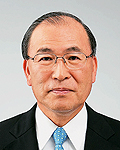
Vice Chairman of the Board of Councillors, Nippon Keidanren
President & CEO, Toshiba Corporation
 |
Atsutoshi NISHIDA Vice Chairman of the Board of Councillors, Nippon Keidanren President & CEO, Toshiba Corporation |
In this deep, unparalleled economic crisis, strength of will and the ability to get things done are much sought after qualities. At the same time, we are also presented with an excellent opportunity to make careful preparations in anticipation of economic recovery. Since last year, (in a way that is without past precedent,) semiconductor memories have been hard hit by a slump in prices and yen appreciation, while system LSI and discrete semiconductors have seen profit crumble. It is as if the semiconductor industry had been hit by a devastating earthquake. However, to only see the current situation would be to ignore the future.
With the invention of the transistor in 1948, and its subsequent application in semiconductor integrated circuits, feature sizes have undergone steady miniaturization, with the rate of integration following Moore's law and routinely doubling every eighteen months to two years. The circuits etched on today's cutting-edge semiconductors are now as fine as 30-nanometers or so (1 nanometer is 1/1,000,000,000 of a meter). These advances have made it possible to achieve very high rates of integration, to boost speeds and cut prices. In that process, semiconductor integrated circuits have become the "rice of industry," a staple of all sorts of businesses. Figures from the Japan Electronics and Information Technology Industries Association (JEITA) indicate that the global production output of the electronics and IT industry in 2008 had a value of ¥237 trillion, ¥28 trillion of which was produced by the semiconductor industry.
Semiconductor integrated circuits have provided the driving force for the creation of many and diverse new products — from personal computers and digital cameras to mobile phones and the internet itself — that have spread throughout society. More recent progress in applying integrated circuits to automobiles and social infrastructure is now supporting reform of society at a basic level. The already huge volumes of data processed by the networks, routers and servers that comprise the internet will continue to grow exponentially. If we are to achieve this with energy-saving green IT technology, we will rely heavily on progress in semiconductor technology. The same is true in other areas, and there can be no doubt that the number of fields relying on the latest semiconductors will continue to increase. Applications we can anticipate include the creation of ultra-miniature simultaneous translation devices that allow the people of the world to achieve communication and mutual understanding with one another in their native languages, and the use of mobile sensors to support health management and remote medical care.
Economic development in the emerging nations during the 1990s first attracted the manufacture of commodity products. Production of electronic devices and semiconductors followed, a move that undermined the predominance of Japanese-made goods. The semiconductor industry is now heading for restructuring, and in the face of this we must push forward and promote measures for improved competitiveness. Strengthening the competitiveness of the semiconductor industry will also advance the IT industry and its ten-times bigger market, and will have positive impacts on the automobile and social infrastructure industries. I have complete faith that this kind of "multiplier effect of innovation," arcing over different industries, will help to restore the Japanese economy and provide the impetus for sustained growth.